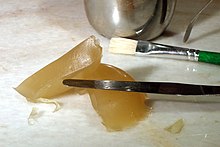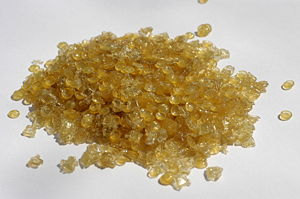Varieties and makes use of
Animal glue was the commonest woodworking glue for hundreds of years till the appearance of artificial glues resembling polyvinyl acetate (PVA) and different resin glues within the 20th century. Right now it's used primarily in specialty purposes resembling lutherie, pipe organ building, piano repairs, and vintage restoration. Glass artists benefit from conceal glue's capacity to bond with glass, making use of conceal glue to glass. Because the glue hardens it shrinks, chipping the glass.
It has a number of benefits and downsides in comparison with different glues. The glue is utilized scorching, sometimes with a brush or spatula. Glue is saved scorching in a glue pot, which can be an electrical unit constructed for the aim, a double boiler, or just a saucepan or crock pot to offer a heat water tub for the container of glue.
Most animal glues are soluble in water, helpful for joints which can at a while should be separated. Alcohol is typically utilized to such joints to dehydrate the glue, making it extra brittle and simpler to crack aside.
Particular varieties embody conceal glue, bone glue, fish glue, rabbit pores and skin glue.
Conceal glue
Conceal glue is utilized in woodworking. It might be equipped as granules, flakes, or flat sheets, which have an indefinite shelf life if saved dry. It's dissolved in water, heated and utilized heat, sometimes round 60°C (140°F). Hotter temperatures shortly destroy the energy of conceal glue. Business glue pots, easy water baths or double boilers could also be used to maintain the glue scorching whereas in use. As conceal glue cools, it gels shortly. At room temperature, ready conceal glue has the consistency of stiff gelatin, which is the truth is an analogous composition. Gelled conceal glue doesn't have important energy, so it's vital to use the glue, match the items, and maintain them regular earlier than the glue temperature drops a lot under 50°C (120°F). All glues have an open time, the period of time the glue stays liquid and workable. Becoming a member of elements after the open time is expired leads to a weak bond. Conceal glue's open time is normally a minute or much less. In observe, this typically means having to warmth the items to be glued, and gluing in a really heat room, although these steps will be allotted with if the glue and clamp operation will be carried out shortly.
The place conceal glue is in occasional use, extra glue could also be held in a freezer, to stop spoilage from the expansion of microorganisms. Conceal glue has some hole filling properties, though trendy gap-filling adhesives resembling epoxy resin are higher on this regard.
Conceal glue that's liquid at room temperature can also be potential by the addition of urea. An instance of this kind of combination is Outdated Brown Glue, created by W. Patrick Edwards, the director of the American Faculty of French Marquetry. In stress checks carried out by Mark Schofield of Positive Woodworking Journal, liquid conceal glue in contrast favourably to scorching conceal glue in common energy of bond. "Nevertheless, any liquid conceal glue over six months previous will be suspect as a result of the urea ultimately hydrolyzes the protein construction of the glue and weakens it ? although the product was 'protected' with numerous bactericides and fungicides throughout manufacture."
Manufacturing
Animal hides are soaked in water to provide "inventory." The inventory is then handled with lime to interrupt down the hides. The hides are then rinsed to take away the lime, any residue being neutralised with a weak acid resolution. The hides are heated, in water, to a rigorously managed temperature round 70 levels Celsius. The 'glue liquor' is then drawn off, extra water added, and the method repeated at growing temperatures.
The glue liquor is then dried and chipped into pellets.
Properties
The numerous disadvantages of conceal glue ? its thermal limitations, quick open time, and vulnerability to micro-organisms ? are offset by a number of benefits. Conceal glue joints are reversible and repairable. Not too long ago glued joints will launch simply with the applying of warmth and steam. Conceal glue sticks to itself, so the repairer can apply new conceal glue to the joint and reclamp it. In distinction, PVA glues don't adhere to themselves as soon as they're cured, so a profitable restore requires removing of the previous glue first ? which normally requires eradicating a few of the materials being glued.
Conceal glue creates a considerably brittle joint, so a powerful shock will typically trigger a really clear break alongside the joint. In distinction, cleaving a joint glued with PVA will normally harm the encircling materials, creating an irregular break that's harder to restore. This brittleness is taken benefit of by instrument makers. For instance, devices within the violin household require periodic disassembly for repairs and upkeep. The highest of a violin is well eliminated by prying a palette knife between the highest and ribs, and operating it throughout the joint. The brittleness permits the highest to be eliminated, typically with out important harm to the wooden. Regluing the highest solely requires making use of new scorching conceal glue to the joint. If the violin high have been glued on with PVA glue, eradicating the highest would require warmth and steam to disassemble the joint (inflicting harm to the varnish), then wooden must be faraway from the joint to make sure no cured PVA glue was remaining earlier than regluing the highest.
Conceal glue additionally features as its personal clamp. As soon as the glue begins to gel, it pulls the joint collectively. Violin makers might glue the middle seams of high and again plates collectively utilizing a rubbed joint reasonably than utilizing clamps. This system entails coating half of the joint with scorching conceal glue, after which rubbing the opposite half in opposition to the joint till the conceal glue begins to gel, at which level the glue turns into cheesy. At this level the plate is put aside with out clamps, and the conceal glue pulls the joint collectively because it hardens.
Conceal glue regains its working properties after cooling whether it is reheated. This property can be utilized when the glue's open time doesn't enable the joint to be glued usually. For instance, a cello maker might not be capable of glue and clamp a high to the instrument's ribs within the quick one-minute open time accessible. As an alternative, the builder will lay a bead of glue alongside the ribs, and permit it to chill. The highest is then clamped to the ribs. Shifting a number of inches at a time, the maker inserts a heated palette knife into the joint, heating the glue. When the glue is liquefied, the palette knife is eliminated, and the glue cools, making a bond. The same course of can be utilized to attach veneers to a substrate. The veneer and/or the substrate is coated with scorching conceal glue. As soon as the glue is chilly, the veneer is positioned on the substrate. A scorching object resembling a garments iron is utilized to the veneer, liquefying the underlying glue. When the iron is eliminated, the glue cools, bonding the veneer to the substrate.
Conceal glue joints don't creep beneath hundreds. PVA glues create plastic joints, which can creep over time if heavy hundreds are utilized to them.
Conceal glue is equipped in many alternative gram strengths, every suited to particular purposes. Instrument and cupboard builders will use a variety from 120 to 200 gram energy. Some conceal glues are offered with out the gram energy specified. Skilled customers keep away from this glue because the glue could also be too weak or robust for the anticipated software.
Hoof glue
Hoof glue can also be used immediately in woodworking, particularly cabinetry.
Rabbit-skin glue
Rabbit-skin glue is extra versatile when dry than typical conceal glues. It's used within the sizing or priming of oil painters' canvases. It is also utilized in bookbinding and because the adhesive part of some recipes for gesso and compo.


